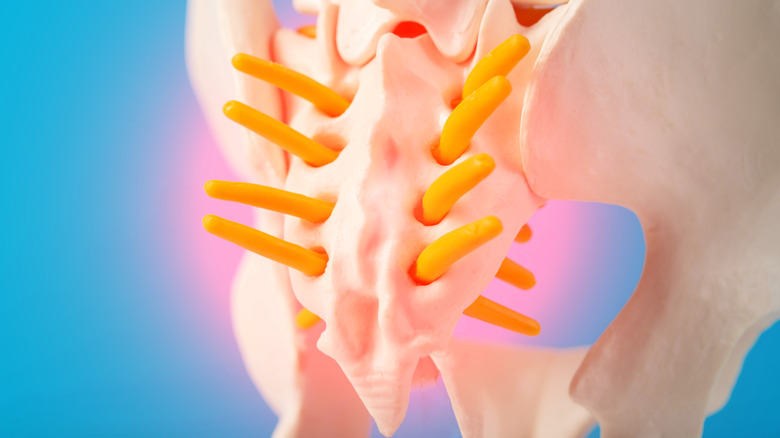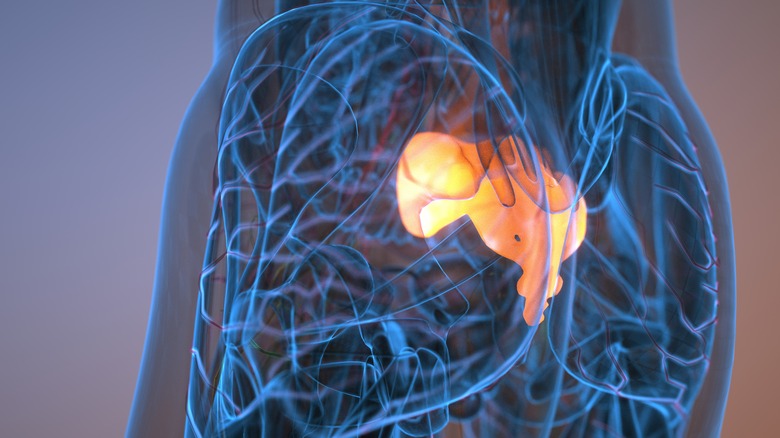The 'Useless' Part Of Your Spine That's Actually Important
Anatomical structures can be broken down into three groups: homologous, analogous, and vestigial. Vestigial structures are essentially leftovers from our evolutionary journey, though there is some debate over the definition of the term. Generally, vestigial parts of our anatomy are thought of as remnants of a structure that at one time served a purpose but has long since become useless. Many biologists, however, maintain that vestigial structures can still perform functions, even if their main purpose no longer applies. Theorizing on more than just evolution, Charles Darwin proposed as much back in 1859, and many biologists take the view that vestigial structures may have lost their primary function but can also perform others.
A wide range of animals have vestigial elements. Pythons and boa constrictors, for example, possess very small leg bones hidden in muscles near their tail ends, while some whales have pelves that no longer help with locomotor function. In the latter case, however, the whale pelves still anchor muscles associated with the reproductive system.
Which brings us to, well, ourselves. It seems we actually share something in common with whales, as it turns out our tailbones, or coccyx, are also very important for the surrounding muscles, tendons, and ligaments. This vestigial element of our anatomy once formed part of a tail that we've long since lost as part of our evolutionary journey. But as we know, vestigial structures aren't always completely useless, and that's no different for our coccyx.
The coccyx once formed part of our tails
From our wisdom teeth to our auricular muscles, which once controlled the movement of our ears, humans have a wide range of vestigial features. But many of these aren't quite as useless as we think. The human appendix, for example, was long thought to be a "useless" organ that is now known to be more important than we thought, and those seemingly defunct auricular muscles can still be used by some people to move their ears.
Likewise, just because we don't have tails anymore doesn't mean the last vestige of that tail is completely redundant. Our tailbones are actually made up of three to five vertebrae which have fused together, forming a structure that's between 40 and 100 millimeters in length. It sits at the bottom of the spine and is the final segment of the vertebral column. At one time, this small part of our spinal anatomy formed part of a tail which our primate ancestors used for a variety of tasks, from gripping branches of trees to maintaining balance. We have, of course, long since lost our tails, which disappeared from the fossil record between 25 million to 20 million years ago. Researchers have only recently discovered an important genetic mechanism that played into this loss of our tail. A 2024 study published in Nature identified the AluY element as having jumped into a gene called TBXT which led to the loss of tails in apes, including our ancestors'.
But just because we're not swinging between trees and can hold our balance without tails, doesn't mean the remnants of those tails are completely useless. In fact, our coccyx play several important roles.
Our coccyx are more useful than we think
Our tailbones are vestigial, but like so many vestigial anatomical structures, they still play several important roles. For one thing, our coccyx anchor several muscles, ligaments, and tendons. The Gluteus maximus muscles and Levator ani (or pelvic floor) muscles are anchored by the coccyx, which also support tendons and ligaments connected to nearby structures as well as nerves.
That's not all our tailbones do, either. They contain the sacrococcygeal symphysis, a joint with minimal movement that helps with pelvic stability. This joint can bend forward and backward and is strengthened by several surrounding ligaments, essentially helping us with movements that involve spinal extension, such as going from a standing to sitting position. There's also the thin Sacrococcygeal disc which absorbs weight from the upper body, essentially acting as a small cushion. On top of that, the coccyx helps with weight distribution by moving forward slightly when we sit. It also moves backward during childbirth, which helps to increase the diameter of the pelvic passage.
For a vestigial part of our anatomy, then, the coccyx have a surprising among of uses that seem to play important roles in various aspects of movement, balance, and even childbirth. So, does that mean our tailbones are an essential part of our bodies? Or can we do without this vestigial element of our evolutionary past?
Can we survive without our coccyx?
With the coccyx playing what seem like some fairly vital roles in our everyday lives, it almost seems as if life without our vestigial tailbones would be quite difficult. But many people can and do live without this small piece of vertebral column. In some cases, injuries to the coccyx can be severe enough that individuals might need what's known as a coccygectomy, whereby the tailbone is removed altogether. This is, however, usually a last resort.
Due to the fact that muscles, tendons, and ligaments are attached to the coccyx and because it helps support our weight, doctors will try more conventional treatments before they remove it completely, and even then a coccygectomy is reserved for those with chronic or severe pain, typically resulting from a dislocation or fracture. While those who undergo such a procedure will usually live a perfectly normal life, sitting comfortably might become an issue following a coccygectomy.
A 2022 study published in the International Journal of Spine Surgery looked at 173 patients who had undergone coccygectomy from 2006 to 2019. It found that surgical history, age, gender, and the cause of pain all had a big influence on success following coccygectomy. Older age patients were shown to experience continued disability after their operation, and those with a history of spine surgery and women had inferior outcomes compared to other patients. But for those who have exhausted other options while dealing with severe coccyx pain, surgery can provide major relief and doesn't mean those individuals will have to deal with a significantly reduced quality of life. Still, this vestigial structure at the base of our spines is clearly a lot more important than you might think.



